| Botanical Name |
|
| Family |
Asteraceae - The daisy family. |
| Pronunciation |
brak-ee-LAY-nuh DISS-kuh-luh |
| Common Name(s) |
English: Coastal Silver-oak
Afrikaans: Kusvaalbos; Kreukelboom
IsiZulu: UmPhahla; Isiphahluka
Sesotho sa Leboa: Mphahla
|
| Plant Group |
- Tree A woody, self-supporting perennial plant usually with a single main stem and generally growing more than 6 meters tall.
|
| Plant Size |
- Small
| Tree | 4m to 8m |
| Shrub | 50cm to 75cm |
| Perennial/ground cover | 10cm to 20cm |
| Bulb | 20cm to 30cm |
| Succulent | 10cm to 20cm |
|
| Position |
- Canopy Shade Canopy shade is found below closely grown trees where some light filters through. Ideal for the protection of herbaceous plants.
- Dry Shade Shady areas where soil has poor water retention or are dependent on rain for their moisture needs.
- Light or Dappled Shade Found below trees with sparse, open foliage. Ideal for the protection of herbaceous plants.
- Partial Shade The area is in shade for part of the day and in full sun for part of the day.
- Sun The area is in full sun for all or most of the day, all year round.
|
| General Information |
- Drought Tolerance: High The plant is well adapted to arid conditions; it can survive long periods of drought and high temperatures without extra water.
- Evergreen Plants that have leaves all year round.
- Frost: Hardy The plant can withstand freezing temperatures or frost without artificial protection.
- Roots Non-invasive Safe to plant near pools, paving, walls or buildings.
- Salt spray tolerant A plant with specific adaptations enabling it to grow in a saline environment.
- Sand tolerant Plants adapted to survive in nutrient poor, very sandy soils.
- Water Wise Plant species originating from low rainfall regions that require less water to survive and thrive than other plant species.
- Wind Tolerant Plants able to withstand the effect of strong winds.
|
| Specific Information |
The movement of the wind through the tree exposes the lovely silver undersides of the leaves. The male and female flowers are borne on separate trees. Brachylaena discolor can be grown as a large shrub if regularly trimmed to size, as it tolerates pruning.
|
| Ad Break |
|
| Flowers |
| Description |
small thistle-like blooms in large sprays
|
| Season |
- Autumn to Winter Plants will seldom bloom for the entire season as given in the list, but should flower during a period within these parameters.
- Winter to Spring Plants will seldom bloom for the entire season as given in the list, but should flower during a period within these parameters.
|
| Colour |
|
| Growth Rate |
- Very Fast Specifying growth rate can be very misleading as there is considerable variation of growth rate depending on type and species of plant, available water, supplementary feeding, mulching and general care, as well as the plants suitability and adaptability to the garden environment.
|
| Plant Uses |
- Attracts bees, butterflies or other insects This plant attracts insects which can be food for birds or other creatures in your garden.
- Attracts Birds This plant will attract birds.
- Border A strip of ground, at the edge of a driveway or path in which ornamental plants or shrubs are planted.
- Boundary A plant useful for planting around the edges of the property to form a green or colourful backdrop, an impenetrable hedge, to hide walls or create privacy.
- Container Trees, shrubs and ornamental species that can adapt to growing in a restricted environment.
- Filler Either a fast growing tree or shrub used temporarily to fill in an area while the permanent plants grow to a desired size, or a plant used to fill gaps in borders or beds.
- Foliage Plant Plants grown because their foliage is colorful or unique. Many of these plants have insignificant flowers.
- Hedge Suitable trees or shrubs planted relatively close together so that the branches intertwine to create a barrier. This can be formal – the plants are regularly trimmed to produce a neat shape, or informal – the plants are left to themselves to create a natural hedgerow.
- Pioneer for new gardens A very fast growing plant, able to withstand hardship, that can be used to populate land that has recently been cleared of natural vegetation. These plants pave the way for slower-growing species by adding nutrients to the soil and creating leaf litter.
- Provides light / dappled shade A tree with an open to sparse canopy, through which varying degrees of sunlight can penetrate.
- Screen A tall hedge of suitable plants planted closely together and used as a windbreak, to block a bad view, to separate parts of the garden or as a backdrop.
- Stabilize Banks Plant is used to prevent soil erosion because their roots will form a mat that stabilizes the soil and keeps it from washing away in heavy rains.
- Suitable for coastal gardens Plants adapted to dry, sandy soil, forceful wind, limited rainfall and intense sunlight.
- Suitable for seaside gardens Plants that will survive the hostile environment of harsh salty winds, dry sandy soil, irregular rainfall and heat found in seaside gardens.
- Suitable for smaller gardens Such plants do not have invasive root systems, remain small or controllable and can often be grown in containers.
- Wild Garden An indigenous garden planted for the benefit of wildlife and birds. Provides food, water, a variety of mini-biomes and no poisonous chemicals are used.
- Windbreak Trees planted in a row to form protection from prevailing winds by breaking the force of the wind, thereby reducing wind damage.
|
| Distribution and Habitat |
from the Eastern Cape to KwaZulu-Natal, Mpumalanga and Limpopo, as well as in Mozambique, in coastal and river bush, valley thicket, scrub-land, on rocky outcrops and along the edges of evergreen forests
|
| Planting Suggestions |
|
| Medicinal Uses |
The wood is durable and strong and is used for fence posts, huts, axles, spokes, implement handles, knob-kerries, fishing rods and to construct roofs of huts. The wood is used for carving. The leaves, which are bitter and unpalatable, were used by settlers to treat kidney conditions, as a remedy for diabetes, an enema to stop bleeding of the stomach, as a tonic to treat intestinal parasites and for chest pain. The ashes of the tree were used to provide the alkali for soap making. Brachylaena discolor is reportedly popular with bee-keepers as the flowers make good honey.
|
| Ad Break |
|


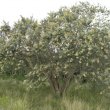
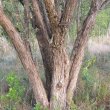
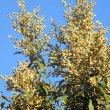


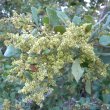

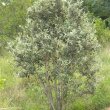


Comments
Coastal silver oak
Can this tree be planted 2 meters from a swimming pool?
Thanks a mil
MiniLowe
Brachylena close to swimming pool
Hi Mini
This would probably be fine as the root system is non-invasive. It may be a good idea to keep the tree pruned so that the branches do not grow too long as they will eventually hang over the pool. During and after the flowering season there will be some debris from the dead flowers blowing or falling into the pool but I imagine that the pool cleaner and filter will deal with this. If you would prefer to let the tree grow without pruning, I would suggest placing it 3 meters away from the pool.
Kind regards
Lorraine
Brachylaena life span
Hi. I would like to know how long this tree lives for.
Brachylaena life span
Hi Lisa
This is one of those queries for which I cannot find an answer - not only for this species, but for the majority of trees. Possibly because there are so many different factors involved that an estimation becomes so broad that it is next to useless.
All I can tell you is that the trees my mother planted on my property are about 30+ years old and are healthy and strong, suggesting that they will still be there for a good many years.
Kind regards
Lorraine
Neighbour wants to cut this tree
Hi. My neighbour wants me to cut my tree down. This tree is approximately 20-30m high and on my property some of the branches are over lapping to his property. I do not want to cut down the tree. What rights do i have and what can i do?
Tree invading on neighbour's property
Hi Elric
The basic ruling is:
The owner of the tree is directly responsible, at his own cost, for cutting and removing all branches and invasive roots up to the boundary line of the neighbouring property, and to monitor any further growth and remove it on a regular basis.
The by-laws of each municipality may differ slightly so contact your local municipality to find out what your specific rights are for your area.
I can see how your neighbour could have a problem with this tree. It is very tall for a residential area and the mess and shade could be a constant irritation and affect the quality of your neighbour's enjoyment of his garden.
In your position I would immediately remove all overhanging branches and any visibly invasive roots, as required by law.
The next step would be lower the tree by about 50%. You may have to get a tree company to do this as it could be quite dangerous. As a further neighbourly gesture, I would offer so remove any debris caused by the tree on a bi-weekly/monthly basis.
Your neighbour, on the other hand, has the right to approach council about the problem and request their intervention. This may lead to you being forced to remove the whole tree at your cost.
Something to consider:
Good neighbourly relations are essential and can even be life-saving in the case of a break-in or emergency situation. I had two events - a fire in my house and another dangerous family situation, and it was the greatest relief to be able to send all three of my children over the wall to safety at my neighbour's home.
I sympathise with your desire to keep the tree as it is but your neighbour also has the right to enjoy his property. Hopefully you will be able to find a happy medium between yourselves.
Kind regards
Lorraine
Coastal silver oak
Hey guys I went to an excursion to WESSA and the tour guide said the leaves are edible. Is this true? I have a few leaves from the coastal silver oak and wanted to know if they are edible. My guide said I must chew all the flavour out then spit the leaf out. Please let me know if this is true.
Are Brachylaena leaves edible?
Hi Mohamed
They are edible but why would you want to chew them? For more information read 'Medicinal Uses' in the above information text.
Kind regards
Lorraine
Coastal silver oak
I have planted 4 trees and 2 are doing very well, but 2 of them have had almost no growth. They are all about 1 meter apart , I water every day, is that too much? The 2 on the right side were planted the same day. I need to cover that at unsightly wall.
Thanks a mil
Mini
Coastal silver oak as a screen
Hi Minnie
My apologies for taking so long to reply to your query.
There are many reasons why some trees thrive and some don't. A slight change in the mineral content of the soil, being pot bound before planting out, damage to roots, overcrowding or perhaps a 'dud' tree, among others. Also bear in mind that all plants, like people, grow at their own pace and to different sizes.
In this case it may be that the trees are too close together and the larger ones are grabbing all the nutrients. However, the photo shows that none of the trees are in any way unhealthy.
Watering daily is not a good idea. Firstly, some of the nutrients in the soil are being leached out by this daily drench and secondly the trees are only getting surface water, but little is filtering deep down into the soil. Shallow watering means the roots do not venture beyond the available water. I would water once a week, but this is a slow trickle for a couple of hours so that the water drains really deeply. This will encourage the root system to expand, thus providing more nutrients and better growth.
In your case, I would alter my watering method and sprinkle a good dose of slow release organic fertiliser like Bounceback, and put a thick layer of mulch over this to keep the soil moist and warm and supply the trees with a boost of nutrients. You should see a difference, if not in a couple of months as winter is moving in, but certainly by next spring.
Hope this helps.
Kind regards
Lorraine
Coastal silver oak---close up of wood /colour -essential
I have cut dead branches here in southern Mozambique sand forest. I am turning bowls, lamps etc. from this wood. Why is there no close up photo of the bark or colour of the cut/sawn wood shown? This will help to identify this tree.
Another site says the wood is "yellow" but does not describe the particular shade of yellow. To my eyes it appears pale yellow. Detailed photos would identify this tree. I am only assuming this wood is Coastal silver oak.
Close up of wood non-essential
Hi Carl
This website has been developed specifically for gardeners for whom the colour of the wood is not an essential for identification of the tree, given all the other information provided. The bark of the tree is very specific and unmistakeable, as shown in picture 2 above.
Kind regards
Lorraine
Coastal silver oak - Zulu name in Mozambique
The local Zulus here in Makatini flat all unanimously call this tree, (Brachylaena discolour) Ikhonono, yet all other indigenous tree sites have the Zulu name as Mphahla or similar - no mention of Ikhonono. Additionally, the Amazulu in this area say Mphahla is not this tree. Can someone clarify?
The wood is yellow and the leaves match the above description and photos. The wood is hard, heavy and durable. It turns and carves well. I have seen carvings in Tanzania & north Mozambique made from this light yellow wood but what is the wood in my photo?
Brachylaena: names and varieties
Hi Carl
I spent some time searching and from your description I think that the wood you are using may come from Brachylaena huillensis, a tree used extensively in Mozambique and Tanzania for carving, with wood of a pale yellow in colour, heavy and hard. The common name is Silver oak (not Coastal silver oak).
Go to the following site for a picture of the flowers and leaves of Brachylaena huillensis:
http://www.ispotnature.org/speciesdictionaries/sanbi/Brachylaena%20huill...
Go to the following site, and read the Introduction for more information pointing to Brachylaena huillensis as the possible source of the wood you are using:
http://www.usa-journals.com/wp-content/uploads/2013/11/Ndakidemi1_Vol112...
And now to names. I have searched all my many resources and have come up with no indication of Ikhonono being used for any tree, anywhere. This probably means that the name is very localised. As there are less than 10 000 Zulu- speaking members out of a population of over 16 000 000 in Mozambique, this would be the case. Mphahla refers only to Brachylaena discolor, not to other members of the Brachylaena family, of which there are nine in South Africa.
Hope you find something of use in this information.
Kind regards
Lorraine
Coastal Silver Oak (Brachylaena)
I planted the shrub two years ago.The tree grew so fast and well to about 2 metres.Sudddenly after a few days of heavy rain,the leaves started curling and it is dying.
Could it be a clay soil? I live in Knysna.
Regards,
Patty
Brachylaena dying
Hi Patty
Apologies for the tardy reply.
Unfortunately I am unable to assess your soil. If you do have a clay soil, it is quite possible that the tree roots have become waterlogged, resulting in the death of the tree.
To get an idea of whether you have a clay soil, Google 'clay soil' and have a look at the images.
Kind regards
Lorraine
BRACHLAENA ---HUILIENSIS ---IKONONO?
Hi lorraine --many thanks for clearing up huiliensis -
so its not coastal silver oak --just silver oak
Ok i am a wildlife artist from zambia --(retired) pro hunter taxidermist /photographer---------
i am on my way to ntshongwe /mbaswan area 2 moro to fotograph those
ikonono trees for you --in detail
Will post the fots of many trees i found there -leaves /bark /pods /close-ups ----as i cannot tolerate the existing
hopeless fotos & data --very vague ---decent fotos are essential for proper id ---of trees here
I have studied every tree in northern zambia---
written much about them ---but here i am lost -----still learning
---ok --appreciate your mass of info ---
( can i post the fotos on my gmail?) -much easier!-( 4 mb)
regards -carl winter
SILVER?------OAK
Hi lorraine
---this tree is anything but silver--silver?
Botanist must have bumped head somewhere
It appears to be a very pale green /olive color amongst the sand forest trees here ---
but calling it silver is misleading --a stretch of a bizzare imagination
i will fotograph this tree from a distance& close up 2 moro
--plus the freshly cut limbs from some trees cut by locals for firewood
Its bright yellow initially ---then soon darkens from uv or fungus
ok ---will post on my email ---7mb will give you greater detail/ better color than any existing fotos i have seen ----no wonder the confusion --some books really have pathetic color /drawings /illustrations ---very frustrating-----
Thanku for the clarification ---and all the data/ on huillensis--
appreciate-- c
coastal oaks seed production
Hi, we have what appear to be both male and female trees in our garden. Only the one tree - [of the 5 in the garden] is currently producing a HUGE amount of fluffy seeds and the others not - would this be just timing,[ie wait a few weeks] or does the one sex not produce these seeds off of the flower buds?
thank you
Jeanne
Coastal Silver Oak
Hi Jeanne
My sincere apologies for not having replied to your query.
I have never been able to tell my male and female trees apart. The flowers are very similar with the male flower being smaller than the female flower. The flowers are indeed fluffy and look like seeds, but on closer observation, each flower looks like a tiny shaving brush. I think what you are seeing is the flowers of one of the sexes, not the seeds, as, if there are no other trees in flower in the area, it is unlikely that the tree is carrying seeds. The species is not self-pollinating - you would have to have a male and a female tree flowering at the same time for pollination and seed development to take place, with only the female tree carrying the seed.
You can go to
http://www.prota4u.org/plantphotos/Brachylaena%20huillensis.full.02.gif
a diagram of Brachylaena huilensis (the flowers are very similar between species):
No. 3: male flower, No. 4: female flower; No. 5: seed
I hope I have answered your question in my rambling.
Kind regards
Lorraine
Yellowing leaves
Hello Lorraine,
Thank you for a very helpful site. I'm hoping you can help me with my silver oaks. We planted a few in our front garden in Muizenberg a week ago. We mixed in quite a bit of compost with the sandy soil & added some bone meal too. We watered them daily for 5 days but now some of the leaves on some trees are starting to go yellow. Are we overwatering? I'm afraid they might be dying, is there anything we can do to stop this process? I look forward to your response! Thank you :)
Yellowing leaves
Hi Maike
My sincere apologies for not having answered your query.
My answer at the time would have been that the yellowing leaves were just a reaction from being transplanted and that the plant would soon recover.
I hope this was the case and that your trees are now thriving.
Kind regards
Lorraine
Coastal Silver Oak - leaves drying up
Hi,
I have a coastal silver oak planted near to a vlei which is pretty salty.
I do water it three times a week with fresh water but wonder whether it is
possibly getting waterlogged. Attached is an image which shows the leaves on the windward side dying off . Is this normal ? Other larger trees of its type ( but further from the salt water ) dont have this,
thanks in advance,
Martin
Coastal silver oak showing signs of stress
Hi Martin
Apologies for not having replied to your query.
There are so many possible reasons for the damage shown and from your description that I can't make a definite diagnosis. All I can really say is that this does not seem to be an ideal placing for this tree and it may be preferable to move it to a less problematic position. Sorry I can't be of more help.
Kind regards
Lorraine
re Coastal Silver Oak
thanks Lorraine , no problem and thanks for taking the time to comment . It has shown some signs of picking up recently so fingers crossed :-) , all the best, Martin
Good to hear
Hi Martin
That is good news. I have noticed that a tree may take a bit of time to adjust to a given situation, after which it continues to grow as expected.
Kind regards
Lorraine
Discuss this plant
Share knowledge, ask a question or give an experience.